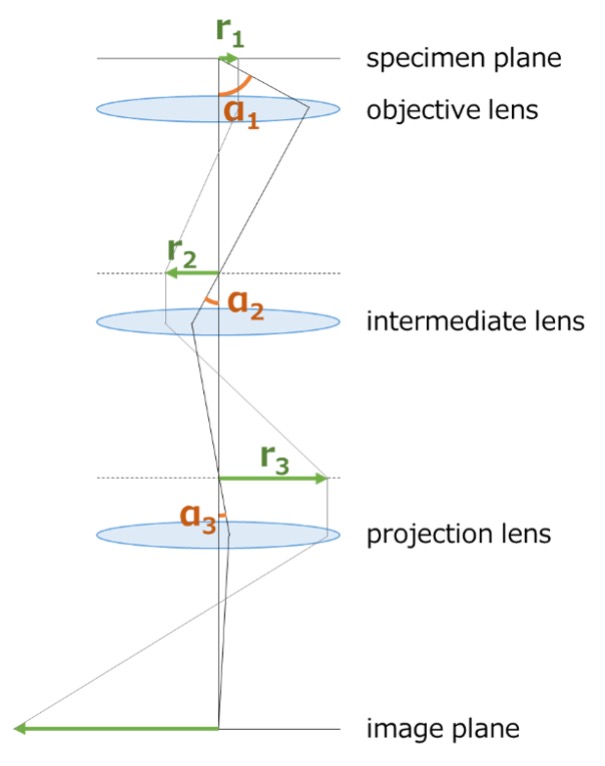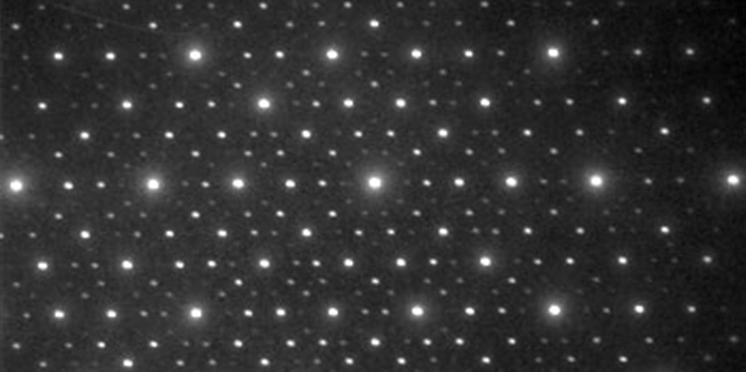軸外幾何収差
軸外幾何収差
off-axial geometrical aberration
[目次:レンズ系]
幾何収差(像面における理想結像からのずれ)は、光軸からの距離rと光軸となす角度(開き角)αの関数として表される。その中で、光軸からの距離rに依存する収差を軸外幾何収差(以下、軸外収差)という(距離rと開き角αの両方に依存する場合も含まれる)。なお、距離rには依存せず、光軸となす角度αのみに依存する幾何収差を、軸上幾何収差(以下、軸上収差)という。
ユーザーが目にする軸外収差としては、像が歪んで見える歪曲収差や、像の周辺部でぼける像面湾曲収差がある(図1)。低倍率で広い視野(およそ10μm×10μm以上)、すなわち光軸から大きく外れた視野、を観察する場合には、軸外収差が重要になる。その場合、結像レンズ系の下段にあるレンズ、すなわち中間レンズと投影レンズの軸外収差が像の劣化(歪みやぼけ)に大きく影響する。これは、レンズで像が拡大されるほど、拡大像の周辺部では光軸からの距離rが大きくなるためである(図2)。
軸外収差としては、光学の原理上避けられない収差であるザイデルの5収差に含まれる歪曲収差(r3に比例)、像面湾曲収差(r2αに比例)、(軸外)非点収差(r2αに比例)、(軸外)コマ収差(rα2に比例)が挙げられる。加えて、電子顕微鏡の磁場レンズは像を回転させる作用も持つため、視野の周辺部で像が回転するS字歪み(r3に比例)を生む。これら以外の軸外収差(寄生収差)は小さく実用上問題になることはない。
結像系には複数の磁場型レンズが用いられているが、各レンズによる軸外収差の向きはレンズの励磁条件によって変わるため、複数のレンズの軸外収差が打ち消しあうように光学系を設計することが可能である。

図1. 軸外幾何収差の例。(a)歪曲収差(r3)、(b)像面湾曲収差(r2α)

図2. 結像系の複数のレンズで像を拡大したときの、光軸からの距離rと光軸となす角αの変化の様子。像が拡大されるほど、像の光軸からの距離が大きくなり(r1 < r2 < r3)、光軸となす角度は逆に小さくなる(α1 >α2 >α3)。軸外収差は光軸からの距離rに依存するため、より下方のレンズ(中間レンズよりも投影レンズ)の収差が像の劣化に影響する。
The geometrical aberrations (departures of the path of electron beams from the path of ideal imaging on the image plane) are expressed as a function of r (distance of the electron beam from the optical axis) and α (opening angle between the electron beam and the optical axis). Among those aberrations, aberrations which depend on r, are called the off-axial geometrical aberrations (hereinafter, referred to be “off-axial aberrations”). The off-axial aberrations also include aberrations which depend on both r and α. It should be noted that the aberrations depending only on the opening angle α are called the axial geometrical aberrations (hereinafter, referred to be “axial aberrations”.
The off-axial aberrations often seen by users are “distortion” and “curvature of image field”. The former causes the distortion of an image (Fig. 1a), and the latter causes a blur towards the periphery of the image (Fig. 1b). The off-axial aberrations are serious when observing a large field of view (approx. 10 μm × 10 μm or more) at a low magnification, i.e. the observation field is well distant from the optical axis. Off-axis aberrations have a significant effect on image degradation (distortion and blurring) at the lower part of the imaging lens system, i.e. the intermediate lens and the projection lens. This is because the more the image is magnified by the lenses, the greater the distance r at the periphery of the magnified image (Fig. 2).
The off-axis aberrations include “Distortion” (proportional to r3), “curvature of image field” (proportional to r2α), “off-axial astigmatism” (proportional to r2α) and off-axial coma aberration (proportional to rα2), which are four aberrations in “Five Seidel aberrations” unavoidable in the optical principle. Furthermore, the magnetic-field lens of an electron microscope rotates the image, producing “S-shaped distortion” (proportional to r3) where the image rotates at the periphery of the field of view. On the other hands, the effect of the “parasitic” off-axial aberrations is small and those aberrations do not cause practical problems.
The imaging system consists of several magnetic field lenses, and the directions of the off-axis aberrations caused by each lens depend on the excitation condition of the lens. Thus, the imaging system can be designed in such a way that the off-axial aberrations of the constituent lenses cancel out to each other.

Fig. 1. Examples of the off-axial geometrical aberrations. (a) Distortion (r3), (b) Curvature of image field (r2α)

Fig. 2. The change in distance r from the optical axis and the opening angle α between the electron beam and the optical axis when the image is magnified by several lenses of the imaging system. The more the image is magnified, the greater the distance (r1 < r2 < r3) and to the contrary, the smaller the angle α (α1 > α2 > α3). Since the off-axis aberrations depend on the distance r from the optical axis, the aberrations of the lower lenses (projection lens rather than intermediate lens) have more effects on degradation of the image.
関連用語から探す
説明に「軸外幾何収差」が含まれている用語






